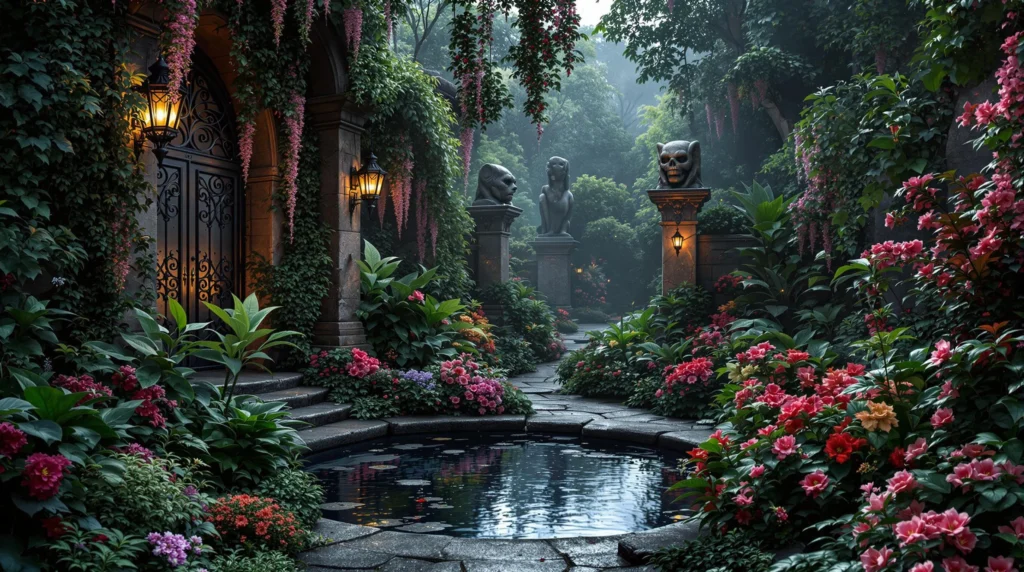10 Hauntingly Beautiful Gothic Garden Ideas for Your Outdoor Space
1. Wrought Iron Elements
Incorporate wrought iron gates, arches, and furniture to establish a quintessential gothic atmosphere. These dark, intricate metalwork pieces add instant Victorian charm while creating striking silhouettes against your plants. A wrought iron gazebo or pergola can serve as a dramatic focal point, while smaller elements like plant stands and trellises introduce the gothic aesthetic more subtly.
2. Dark Foliage and Flowers
Plant varieties with deep purple, burgundy, and black foliage to create a mysterious industry. Black mondo grass, dark dahlias, black tulips, and ‘Queen of Night’ tulips deliver dramatic impact. Complement these with deep purple heuchera, black pansies, and chocolate cosmos for a hauntingly beautiful color palette that embodies gothic romance.
3. Stone Gargoyles and Statuary
Position weathered stone gargoyles and gothic-inspired statues throughout your garden to serve as protective guardians. These sculptural elements create an authentic medieval cathedral ambiance while adding personality to your space. Place them at entrances, on pedestals, or nestled among plants to create surprising encounters throughout your garden journey.
4. Moon Garden Section
Design a dedicated area with white and silver plants that glow under moonlight. White roses, silver artemisia, lamb’s ear, and night-blooming jasmine create an ethereal experience during evening hours. This luminous garden section provides striking contrast against darker elements while embracing the gothic tradition of nocturnal appreciation.
5. Ancient Ruins and Weathered Structures
Introduce architectural salvage pieces or faux ruins to suggest a forgotten, time-worn past. Crumbling stone columns, weathered archways, and moss-covered fragments establish a sense of ancient mystery. These elements can be arranged as focal points or integrated as functional features like benches or planters, adding layers of historical intrigue.
6. Reflective Water Features
Install a small pond with dark-bottomed lining or a vintage birdbath to create reflective surfaces that double your garden’s visual impact. Water elements introduce a contemplative quality while attracting wildlife that enhances the garden’s mysterious atmosphere. The gentle sound of water adds another sensory dimension to your gothic sanctuary.
7. Mysterious Pathways
Create winding pathways using dark gravel, weathered brick, or slate stepping stones that lead visitors on a journey of discovery. Border these paths with towering plants that partially obscure views, building anticipation as one moves through the space. Strategic lighting along pathways enhances their dramatic effect during evening hours.
8. Victorian-Inspired Seating Area
Establish a comfortable retreat with vintage-inspired furniture pieces in dark finishes. A wrought iron bench with plush, deep-colored cushions or a gothic-style table and chair set creates the perfect spot for contemplation. Surround this area with climbing roses or ivy to enhance the romantic, secluded atmosphere.
9. Bell Jar and Cloche Displays
Showcase unusual plant specimens or curated collections under glass domes and cloches. These Victorian-inspired display cases protect delicate plants while adding a cabinet-of-curiosities aesthetic. Fill them with carnivorous plants, unusual succulents, or carefully arranged moss gardens to create mysterious botanical vignettes.
10. Dramatic Lighting Answers
Install carefully positioned low-voltage lighting that casts interesting shadows and highlights architectural features. Wrought iron lanterns, candle sconces, and string lights with smoky bulbs create a moody atmosphere after dark. Consider colored filters in deep blue or purple to enhance the mysterious ambiance of your gothic garden retreat.
Creating a Dark and Dramatic Plant Palette
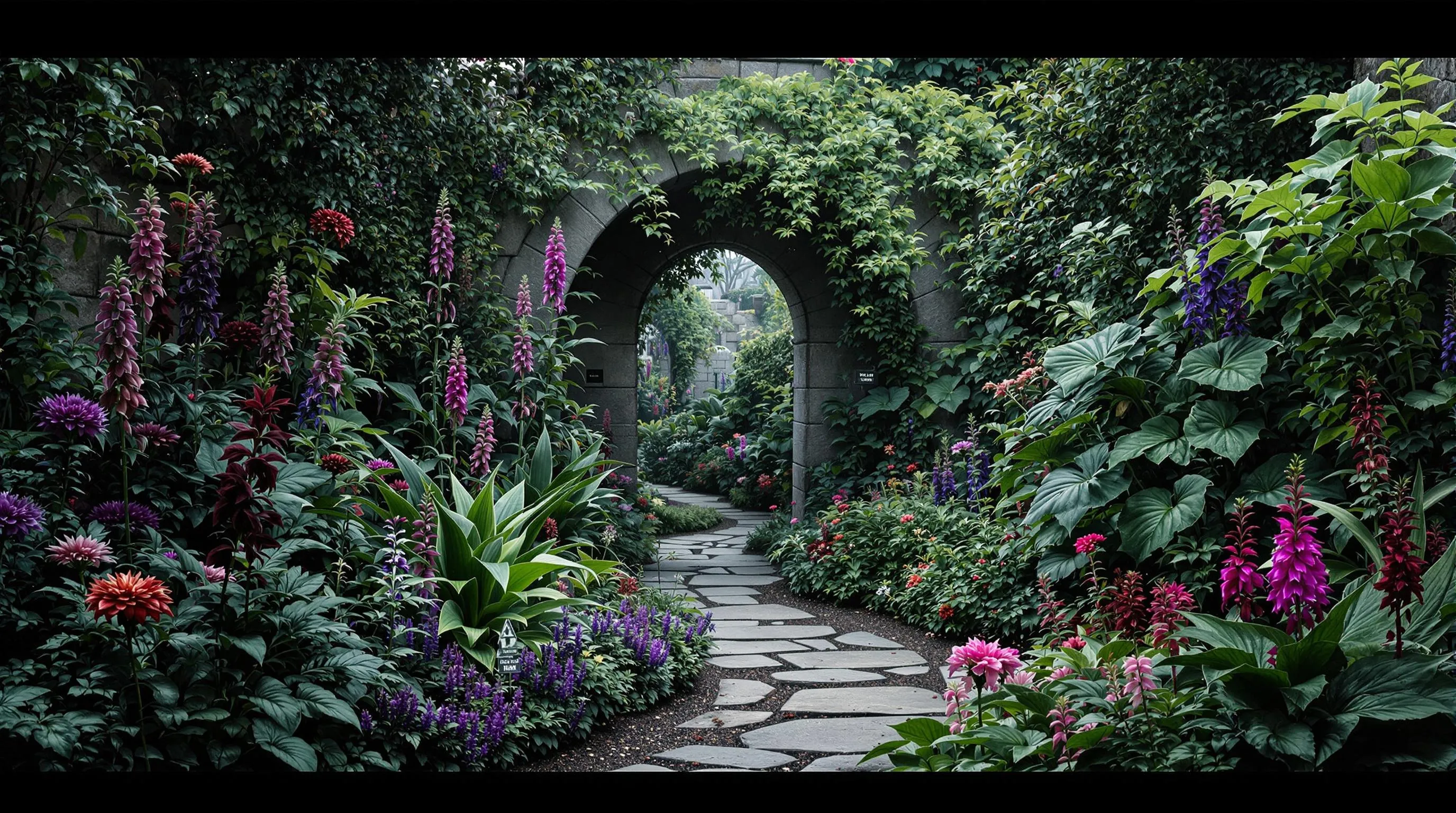
The foundation of any gothic garden lies in its distinctive plant selection. Creating a moody, mysterious atmosphere requires careful consideration of colors, textures, and varieties that evoke the dark romanticism associated with gothic aesthetics.
Midnight-Hued Flowers and Foliage
Dark-colored plants are essential for establishing your gothic garden’s mysterious atmosphere. Black mondo grass (Ophiopogon planiscapus ‘Nigrescens’) creates striking ground cover with its near-black blades that add depth to any area. For dramatic blooms, consider black dahlias like ‘Black Diamond’ or the velvety petals of ‘Queen of Night’ tulips that appear almost black in certain light. Deep purple salvias and the rich burgundy foliage of ‘Black Lace’ elderberry (Sambucus nigra) provide striking vertical elements. Don’t overlook the dramatic impact of ‘Black Magic’ elephant ears (Colocasia) with their massive dark leaves or the shadowy blossoms of black hollyhocks against stone walls. For climbing elements, plant the deep crimson ‘Black Prince’ clematis or the dark purple ‘Black Knight’ butterfly bush to add height and movement to your gothic industry.
Poisonous Plants with Historical Significance
Incorporating historically important poisonous plants adds an authentic touch to your gothic garden while connecting to medieval and Victorian traditions. Foxglove (Digitalis) produces tall spires of bell-shaped flowers and was once used for heart medicine even though its toxicity. The dramatic angel’s trumpet (Brugmansia) features pendulous, trumpet-shaped blooms that release an intoxicating fragrance at night. Consider adding monkshood (Aconitum) with its hooded purple-blue flowers that medieval witches allegedly used in potions. The distinctive seed pods of castor bean (Ricinus communis) with its deep burgundy foliage creates a striking architectural element. For small spaces, potted nightshade plants (Atropa belladonna) with their glossy black berries provide historical intrigue when properly labeled. Always place identification markers beside these specimens with warnings about their toxic nature, especially if you have children or pets, and position them in less accessible parts of your garden as fascinating visual elements rather than interactive plants.
Incorporating Gothic Architectural Elements
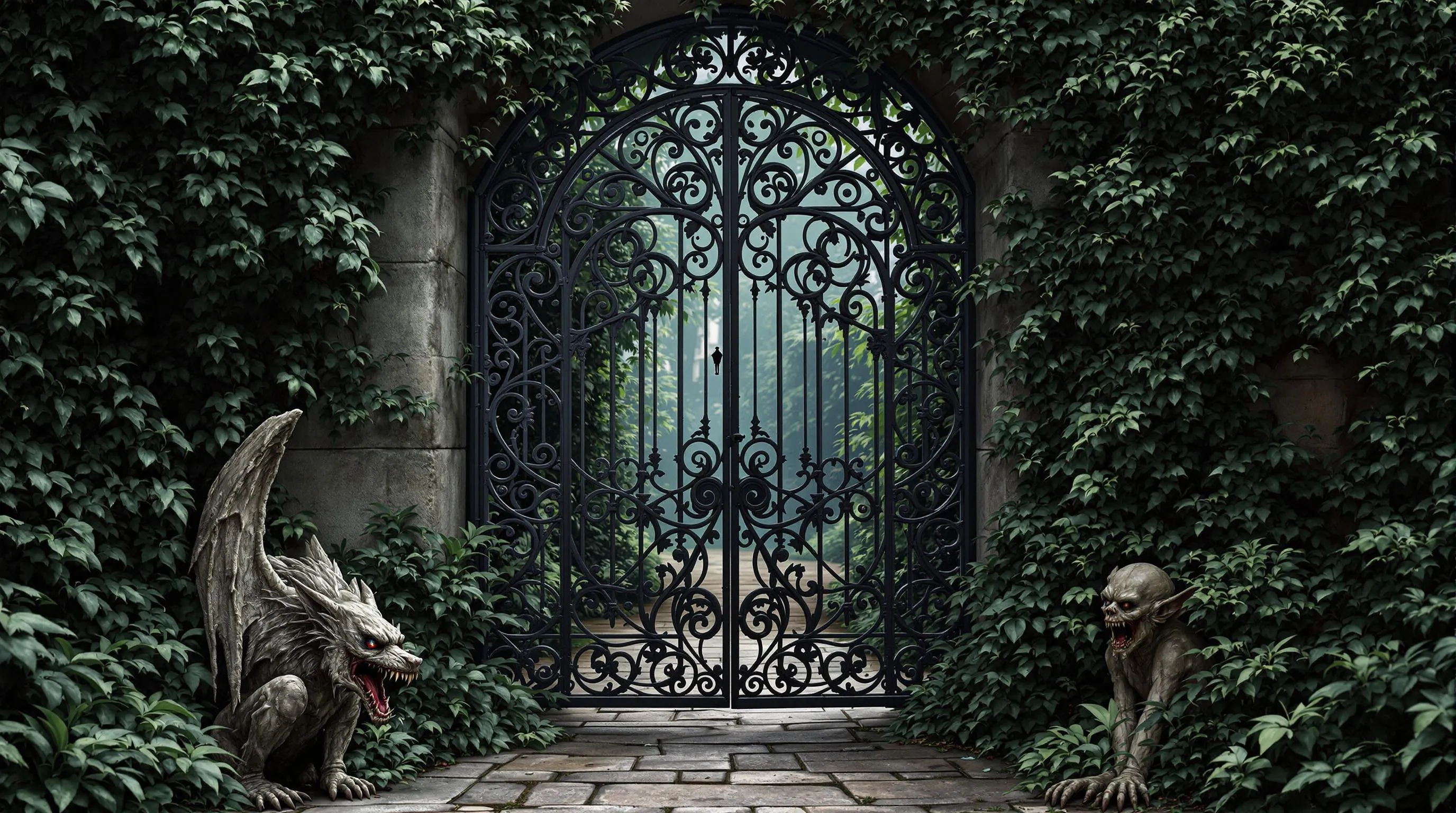
Gothic architecture’s dramatic features can transform your garden into an otherworldly retreat. These structural elements add authentic period charm while creating focal points that anchor your gothic garden design.
Wrought Iron Gates and Fences
Wrought iron gates and fences serve as the perfect threshold to your gothic sanctuary. Install an ornate wrought iron gate with pointed arches and intricate scrollwork to create a dramatic entrance that immediately sets the mood. For maximum impact, choose designs featuring fleur-de-lis patterns, spiked finials, or medieval-inspired motifs. Line your pathways with matching wrought iron fencing to maintain continuity throughout the space. These elements not only provide security but also cast enchanting shadows across your garden when illuminated at night. For a truly authentic look, search for reclaimed Victorian ironwork at architectural salvage yards or commission custom pieces from local blacksmiths.
Weathered Stone Statues and Gargoyles
Weathered stone statues and gargoyles bring ancient mystique to your gothic garden. Position these watchful guardians at entrances, atop pillars, or nestled among dark foliage to create surprising encounters throughout your space. Traditional gargoyles with grotesque features and wings make excellent rainspouts when placed along rooflines or garden walls. For a more subtle approach, incorporate classical statues deliberately aged with moss or lichen to suggest centuries of quiet observation. Consider mythological figures like griffins, chimeras, or gothic angels to enhance the supernatural atmosphere. Create visual hierarchy by varying the sizes of your stone elements, from small decorative pieces to commanding life-sized figures that become the focal point of your garden.
Designing Mysterious Garden Pathways
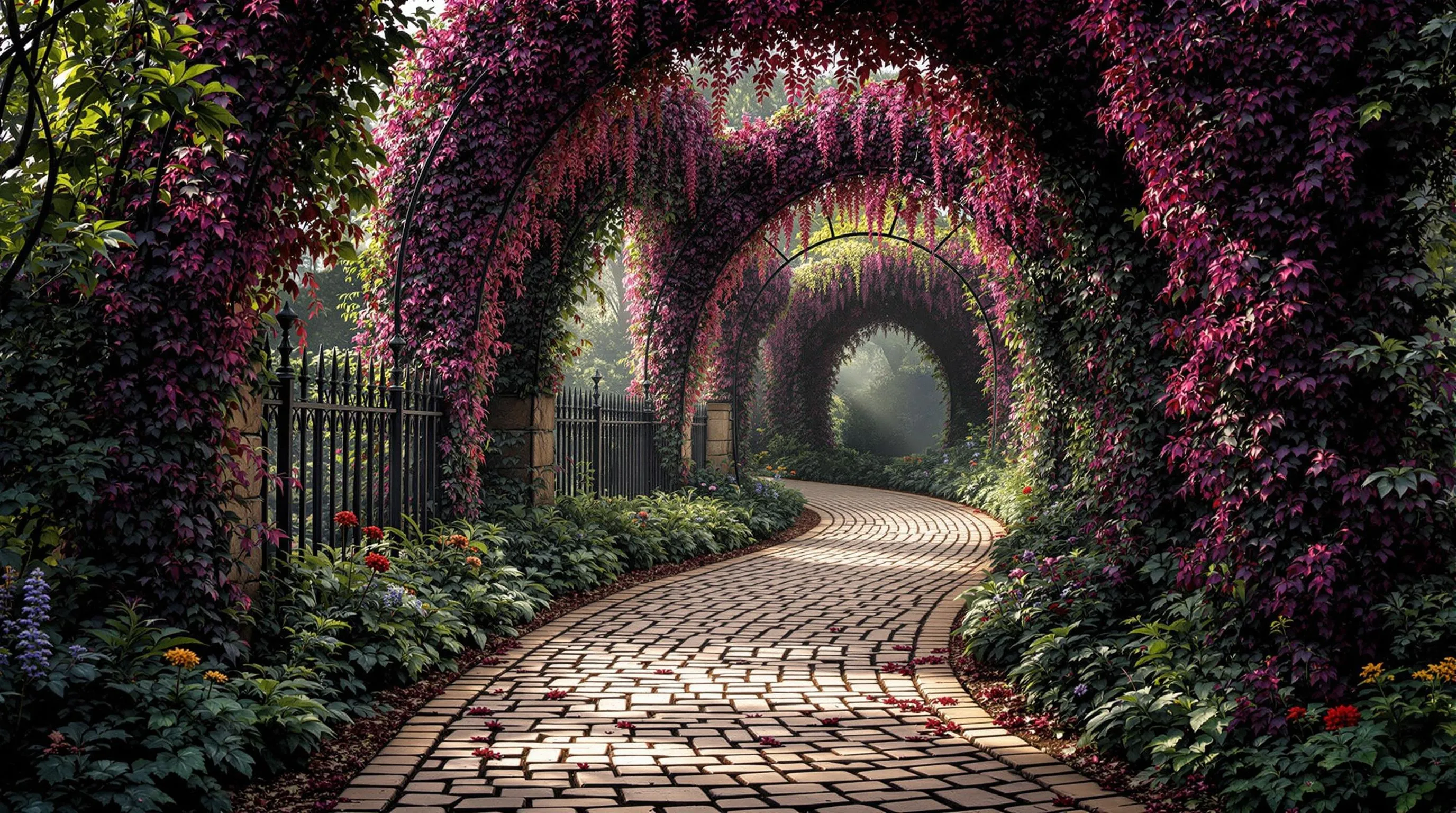
The pathways in your gothic garden serve as more than mere connections between spaces—they’re invitations to explore the unknown. Well-designed pathways create a sense of journey and discovery, leading visitors deeper into your mysterious industry while building anticipation at every turn.
Cobblestone Walkways and Labyrinths
Cobblestone pathways instantly evoke a sense of antiquity and medieval charm that’s perfect for your gothic garden. Choose irregularly shaped stones in dark gray or black for an authentic, centuries-old appearance. Install them with narrow gaps where moss can grow to create that delightfully abandoned aesthetic. For a truly immersive experience, design a simple labyrinth using these cobblestones—it doesn’t need to be complex to be effective. A circular or square pattern with a few twists and turns creates both visual interest and a meditative walking experience. Position ornate lanterns at key turning points to illuminate the path while casting dramatic shadows across the stones. This combination of weathered materials and thoughtful design transforms a simple walkway into a journey through time.
Overgrown Arches and Tunnels
Create enchanting green tunnels by installing metal arches along your pathways and training climbing plants to form natural canopies. Black-painted wrought iron arches provide the perfect structural support while complementing your gothic aesthetic. Select climbing plants like black scented honeysuckle, deep purple clematis, or climbing roses in dark burgundy to create your living ceiling. Position these arches sequentially to form a continuous tunnel effect, creating a passage where dappled light filters through the foliage. This interplay of light and shadow adds mystery while the overhead canopy creates an intimate, enclosed feeling. Allow some strategic overgrowth—vines that hang down slightly or branches that reach inward—to enhance the wild, forgotten quality that’s essential to gothic garden design. These green tunnels become magical transitions between garden rooms, heightening anticipation as visitors move through your darkly romantic industry.
Adding Water Features with a Gothic Twist
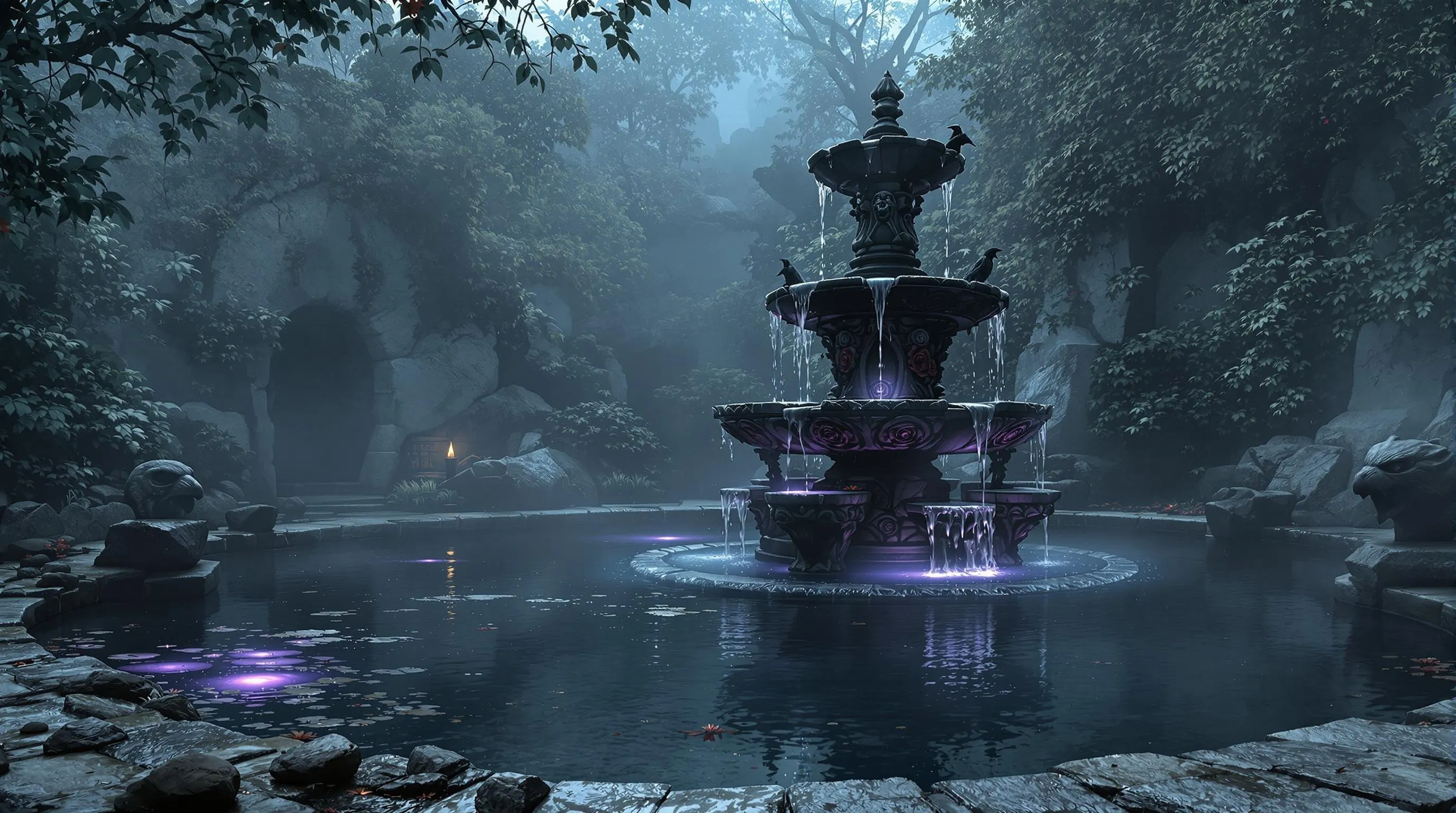
Water elements add a haunting dimension to gothic gardens, creating opportunities for reflection and mystery that perfectly complement the darker aesthetic. By incorporating these liquid features with macabre elements, you’ll create focal points that captivate visitors and enhance the supernatural atmosphere.
Fog-Covered Ponds and Reflecting Pools
Transform your garden with a fog-covered pond that emanates ethereal mystery. Install a small ultrasonic fog machine beneath the water’s surface to create a perpetual mist that hovers just above your pond, especially effective during evening hours. For authenticity, edge your reflecting pool with dark stones or aged concrete featuring worn gargoyle faces that appear to gaze at their reflections. Plant moisture-loving dark foliage like black mondo grass around the edges, allowing it to slightly overhang and cast shadows on the water’s surface. Position your pond where moonlight will reflect off the water, creating dramatic light effects that enhance the otherworldly atmosphere of your gothic retreat.
Ornate Stone Fountains
Install a gothic-inspired stone fountain as the dramatic centerpiece of your garden. Look for designs featuring mythical creatures, Victorian-era figures, or grotesque faces with water pouring from their mouths. Weathered stone or artificially aged concrete in dark gray or black creates an authentic appearance of ancient origins. Consider multi-tiered fountains with intricate carvings of thorny roses, ravens, or medieval symbols for added gothic character. The gentle sound of trickling water creates a contemplative backdrop while highlighting the visual drama of your fountain. Enhance the effect with underwater lighting in deep blue or purple hues that illuminate the falling water after dark, creating mysterious shadows that dance across your garden industry.
Creating Enchanting Gothic Lighting Solutions
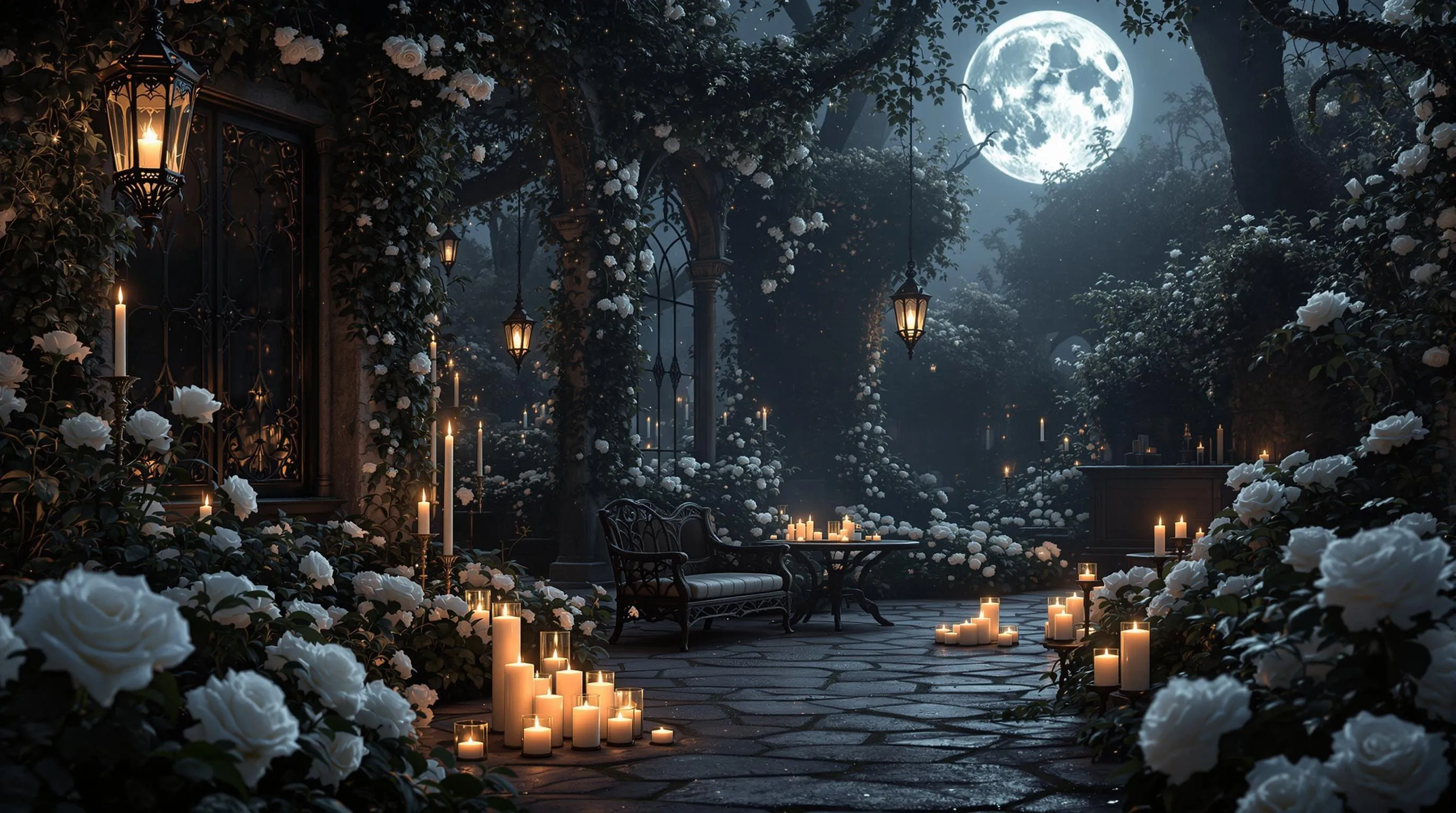
Lighting transforms your gothic garden from merely mysterious to utterly mesmerizing after sunset. The right illumination not only highlights your garden’s features but creates an atmosphere of otherworldly enchantment essential to gothic aesthetics.
Wrought Iron Lanterns and Candle Displays
Install wrought iron lanterns along pathways and hanging from tree branches to cast eerie shadows across your garden. These Victorian-inspired fixtures provide both authenticity and functional lighting while creating dramatic patterns on surrounding surfaces. Place clusters of pillar candles in ornate iron holders for intimate seating areas, allowing the flickering flames to dance against gothic statuary. For safety and convenience, opt for LED flameless candles with realistic flicker effects in outdoor spaces. Position wall-mounted sconces with amber or red-tinted glass beside entranceways to cast a blood-moon glow that instantly sets the gothic mood.
Strategic Moonlight Gardens
Design exact areas to capture and enhance moonlight with strategic placement of reflective elements. Plant white and silver-foliaged specimens like dusty miller, lamb’s ear, and white roses that naturally illuminate under moonlight. Add mirrored gazing balls or mercury glass decorations to amplify available light and create mysterious glimmers throughout the garden. Install discreet uplighting beneath white-flowered climbing plants like moonflower vine or white clematis to simulate moonbeams. For truly dramatic effects, incorporate subtle blue-toned industry lighting among dark foliage to create the illusion of perpetual moonlight, even on cloudy nights. This calculated approach to lighting ensures your gothic garden remains hauntingly beautiful even in darkness.
Selecting Victorian-Inspired Garden Furniture
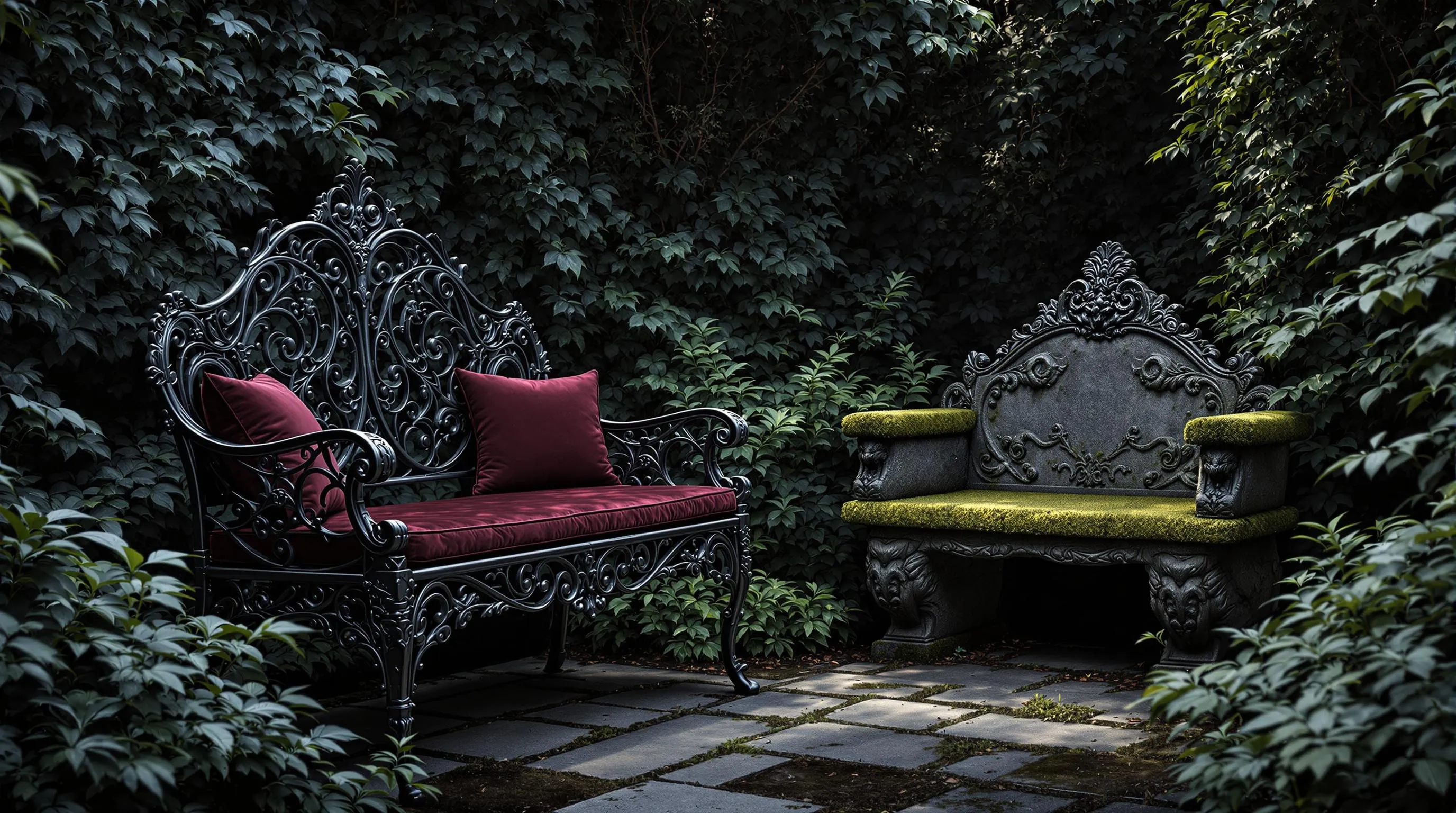
Victorian-era furniture forms the backbone of any authentic gothic garden, providing both functional resting places and dramatic focal points. Your choice of seating can dramatically enhance the historical ambiance and dark romantic atmosphere of your outdoor sanctuary.
Ornate Metal Benches and Chairs
Wrought iron benches and chairs with intricate scrollwork epitomize Victorian gothic style. Choose pieces featuring elaborate curls, floral motifs, and dramatic high backs that create striking silhouettes against your garden backdrop. Black or dark bronze finishes provide the most authentic look, though antique white can offer striking contrast against dark foliage. Position these ornate seating options at the end of winding pathways or nestled within secluded nooks to create contemplative resting spots. For added comfort without compromising style, add deep burgundy, hunter green, or black cushions made from weather-resistant velvet or brocade fabrics.
Moss-Covered Stone Seating Areas
Stone furniture introduces an ancient, weathered element to your gothic garden that suggests centuries of history. Select stone benches with griffins, gargoyles, or lion motifs carved into the sides for authentic Victorian flair. Encourage moss growth on these pieces by applying a mixture of moss, buttermilk, and sugar to create an aged appearance, or place them in shadier sections where moss will naturally develop over time. For a dramatic focal point, arrange a semi-circular stone bench around a prominent water feature or statue, creating a meditative space that feels carved from an abandoned cathedral garden. These substantial seating options provide year-round durability while improving your garden’s mysterious, timeworn aesthetic.
Installing Gothic-Style Garden Structures
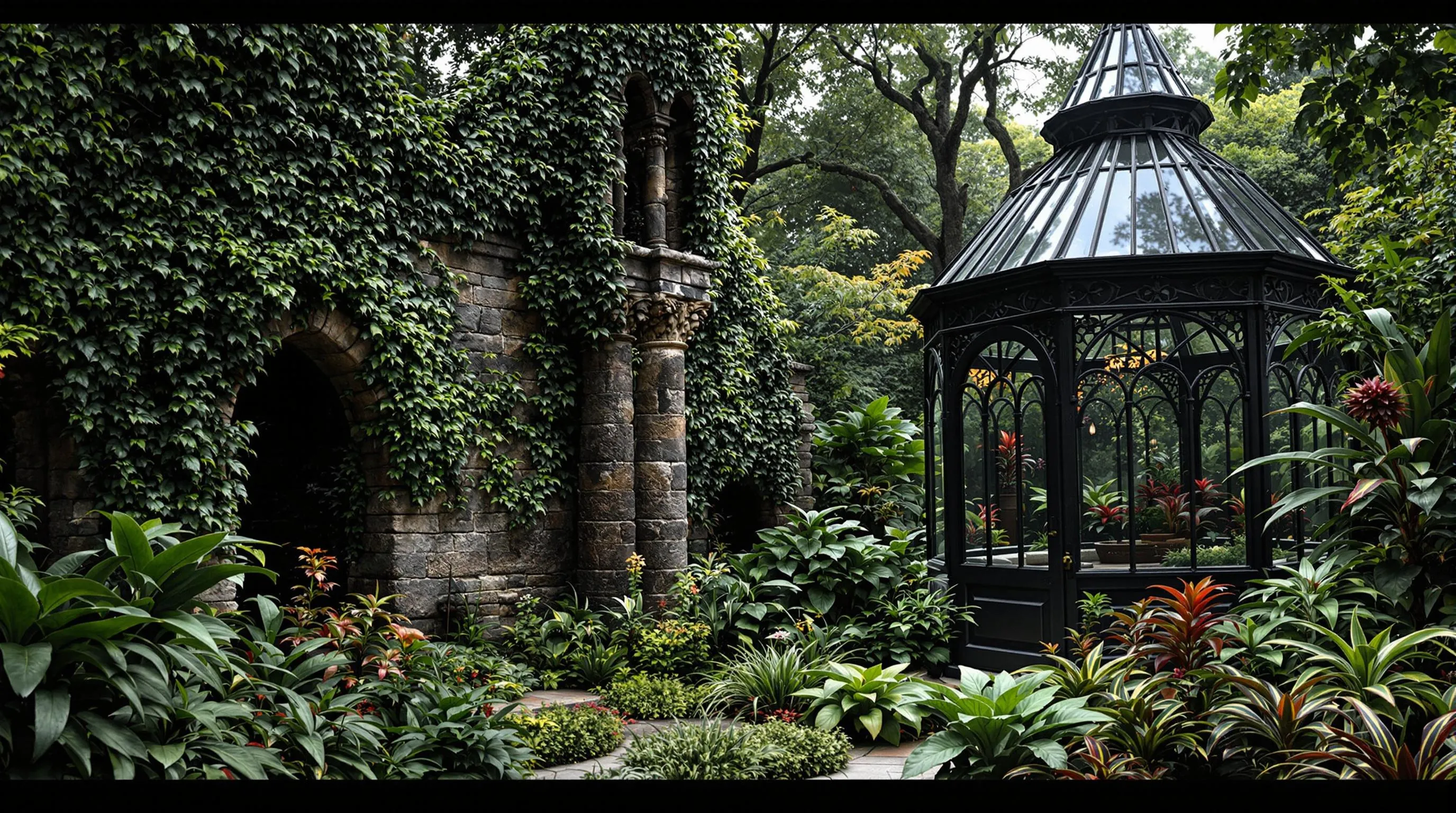
Miniature Ruins and Follies
Transform your garden into a hauntingly beautiful area by installing miniature ruins and follies that evoke centuries past. Create the illusion of ancient abbey remnants with strategically placed stone arches and crumbling wall segments that appear to have withstood the test of time. You can purchase ready-made gothic ruin elements from specialty garden centers or create your own using concrete and molds. Position these architectural fragments partially obscured by climbing vines like dark ivy or black clematis for an authentic abandoned appearance. For a more dramatic effect, consider a scaled-down folly—a decorative structure with no practical purpose—such as a small gothic tower or mock chapel ruin. These structures serve as perfect focal points that invite contemplation while adding historical depth to your garden narrative.
Gothic-Inspired Greenhouses and Conservatories
Elevate your gothic garden with a dramatic Victorian-style greenhouse or conservatory featuring pointed arches and ornate metalwork. These functional structures blend practicality with gothic romance, providing the perfect environment for cultivating exotic plants while serving as architectural centerpieces. Opt for black or dark bronze frames with multiple glass panels divided by decorative mullions to capture authentic gothic architectural details. Inside, arrange collections of unusual specimens like carnivorous plants or rare orchids on wrought iron plant stands. For an extra touch of gothic charm, incorporate stained glass elements in deep purples, blues, and reds that cast colored shadows across your plants. Even a small lean-to greenhouse attached to your home can be transformed with gothic details like decorative finials and cresting along the roofline, creating a mysterious area for your botanical treasures while extending your growing season.
Cultivating a Haunted Herb Garden
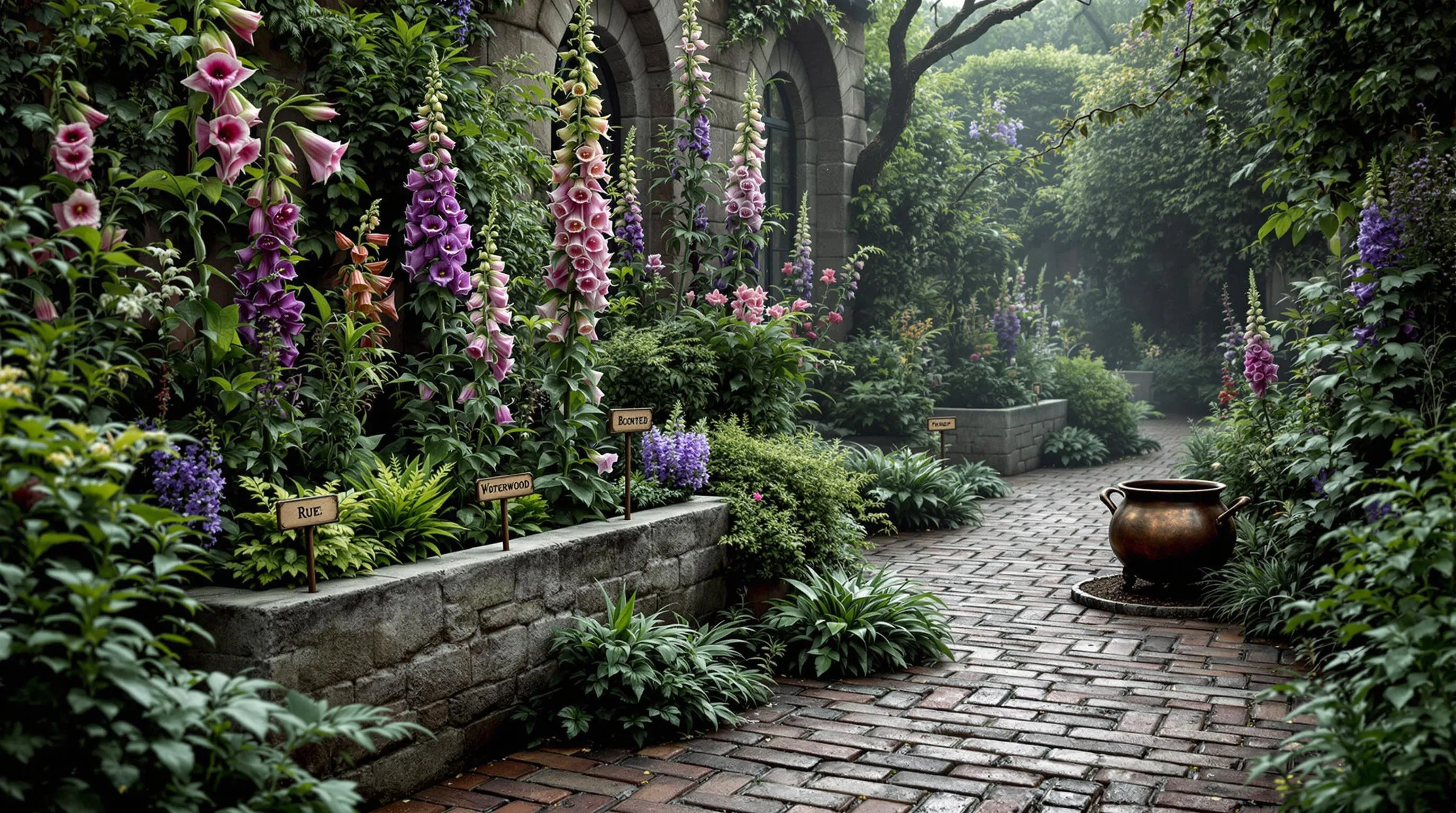
A haunted herb garden combines practicality with gothic mystique, featuring plants that have been used for centuries in folk medicine, witchcraft, and poisoner’s gardens. This specialized garden section not only adds authenticity to your gothic industry but also connects you to ancient herbal traditions with dark histories.
Medieval Medicinal Plants
Medieval medicinal plants form the foundation of any authentic haunted herb garden. Plant foxglove (Digitalis purpurea) with its towering spires of bell-shaped flowers that contain potent heart medicine but can be deadly if misused. Incorporate monkshood (Aconitum napellus) with its dramatic hooded purple blooms once used for arrow poisons and werewolf protection. Add valerian (Valeriana officinalis) with its sweet-scented white flowers that medieval healers prescribed for sleep troubles and nervous disorders. Position these historical specimens in aged terracotta pots or weathered stone planters labeled with antiqued markers describing their medicinal uses and toxic warnings. Create dedicated growing areas using reclaimed brick paths in diamond or herringbone patterns to separate different plant categories according to their traditional uses – healing, protection, or darker purposes.
Aromatic Herbs with Dark Histories
The most compelling haunted herb gardens feature aromatic plants with fascinating dark histories. Plant wormwood (Artemisia absinthium), the key ingredient in absinthe, known as the “green fairy” that supposedly drove artists to madness and was banned for decades. Include rue (Ruta graveolens) with its bluish foliage that was believed to ward off witches yet was also used in their potions. Add mugwort (Artemisia vulgaris), traditionally used to induce vivid dreams and enhance psychic abilities. Arrange these aromatic herbs in a dedicated section where their scents can mingle, creating an immersive sensory experience. Install wrought iron plant supports and gothic-inspired herb markers to enhance the mystical atmosphere. Consider adding a small copper or cast iron cauldron as a decorative focal point, surrounded by your most potent and visually striking herbs for an authentic witch’s garden effect.
Incorporating Seasonal Gothic Elements
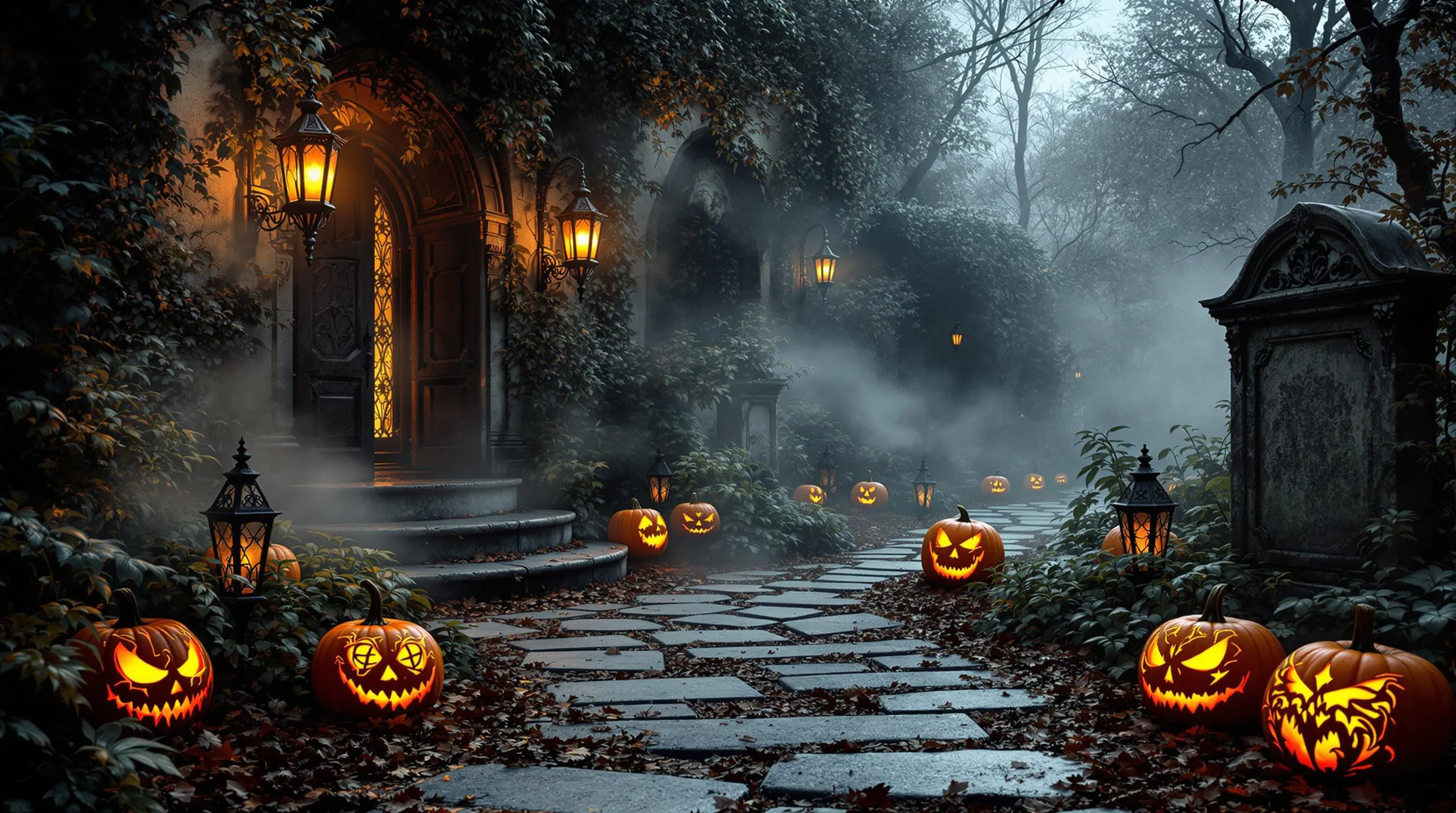
Your gothic garden can transform with the changing seasons, each bringing unique opportunities to enhance its haunting charm.
Halloween-Ready Garden Displays
Transform your gothic garden into the ultimate Halloween showcase with temporary seasonal elements that complement your permanent features. Create a fog-shrouded entrance path using dry ice in hidden containers or portable fog machines placed strategically among your plantings. Hang antique lanterns with flickering LED candles from tree branches to cast eerie, dancing shadows across your garden space. Incorporate vintage cemetery-inspired elements like weathered headstones or a small decorative mausoleum structure nestled among your dark foliage. Display carved pumpkins with gothic motifs—think gargoyle faces, Victorian silhouettes, or intricate architectural designs rather than traditional jack-o’-lanterns. These seasonal touches will make your garden the neighborhood’s most authentically atmospheric Halloween destination while staying true to your sophisticated gothic aesthetic.
Winter Gothic Garden Designs
Winter transforms your gothic garden into its most dramatic incarnation with bare branches creating stark silhouettes against winter skies. Embrace this natural gothic architecture by wrapping trees with warm white string lights to illuminate their sculptural forms. Install dramatic ice features like frozen birdbaths or ice lanterns made by freezing water in balloon molds with botanicals like black roses or nightshade berries embedded within. Create winter interest with evergreen plantings in deep hues—black mondo grass, dark cryptomeria, and blue-black juniper varieties maintain your color scheme year-round. Incorporate wrought iron obelisks or trellises that become striking focal points when dusted with snow or adorned with hoarfrost. Add winter-blooming hellebores (Christmas roses) in dark purple varieties for mysterious winter flowers that emerge from frozen ground. These elements ensure your gothic garden maintains its bewitching presence even in winter’s embrace.
Balancing Beauty and Darkness: Final Thoughts on Gothic Garden Design
Your gothic garden creates more than just a beautiful outdoor space—it crafts an experience that transports visitors to another industry. By thoughtfully combining dark foliage with Victorian elements and mysterious pathways you’ve established a sanctuary that tells your unique story.
Remember that the most enchanting gothic gardens evolve over time. Allow moss to grow naturally on stone features and let climbing vines partially reclaim your structures. This patient approach yields the authenticity that defines truly memorable gothic spaces.
Whether you embrace the full drama of gothic design or simply incorporate a few moody elements your garden will stand apart from conventional landscapes. It’s this willingness to explore the darker side of beauty that makes gothic gardening such a rewarding try for those drawn to its haunting allure.

